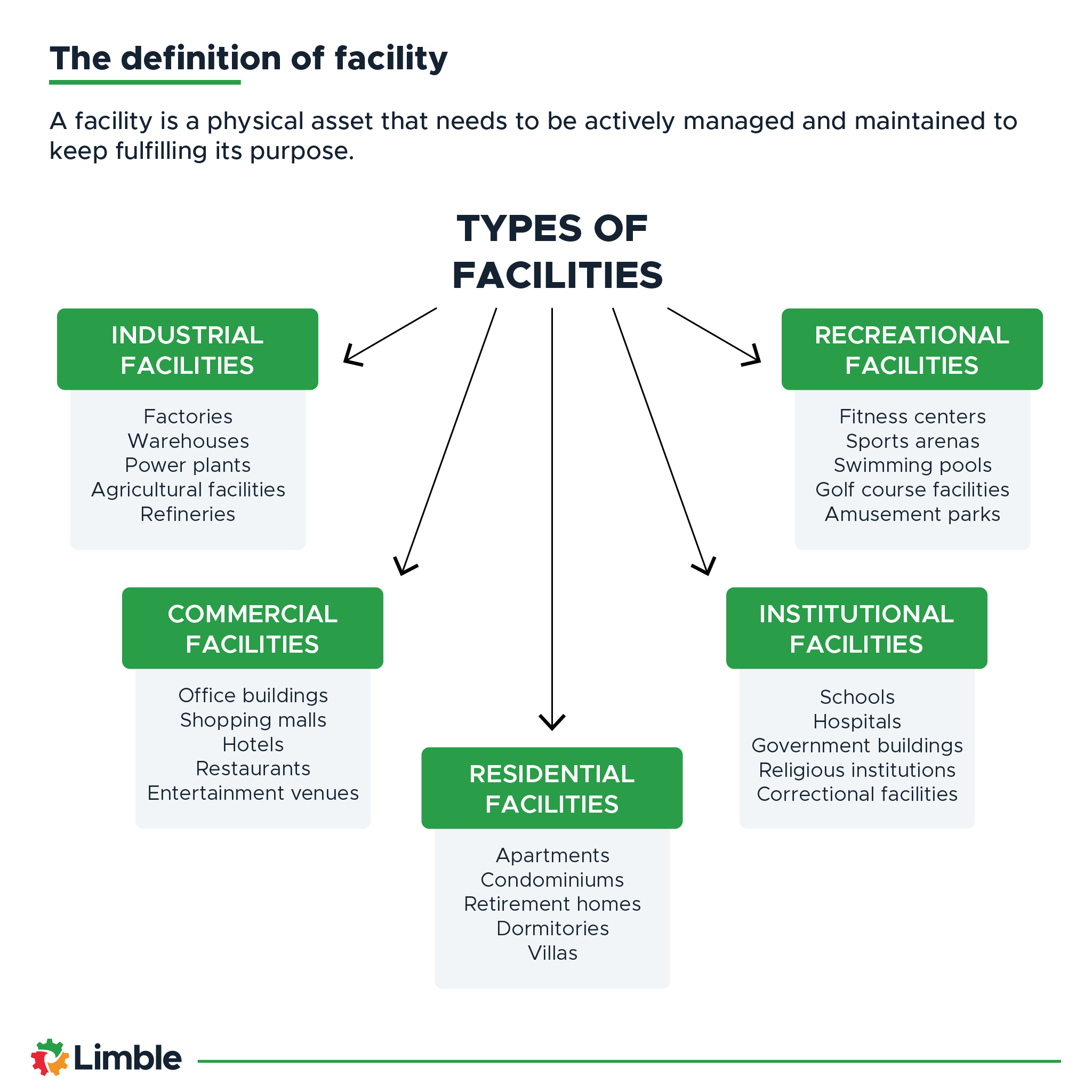The infrastructure around us isn’t just bricks and concrete; it’s a complex blend of function, design, and experience. From towering skyscrapers to busy production floors to lively school classrooms, these facilities serve many different purposes.
What’s the main thing they have in common? They all need effective facilities management to stay safe, presentable, and functional. We will explore these diverse facilities and shed light on their specific management needs.
The definition of facility in the context of facility management
A facility is a physical asset that needs to be actively managed and maintained to keep fulfilling its purpose.
Regardless of that purpose — commercial activities in an office building, educational pursuits in a school, medical care in a hospital, manufacturing processes in an industrial plant — a facility usually includes systems, equipment, furniture, and other assets that together create an environment that enables its intended function.
Facility management, then, is the integrated management of these spaces and assets to ensure their functionality, comfort, safety, and efficiency. This involves various building maintenance, cleaning, energy management, and space optimization tasks, among many others.
Types of facilities that need regular upkeep
There are many different types of facilities and they all have unique requirements and nuances involved in their upkeep.

Industrial facilities
Industrial facilities are the backbone of production, manufacturing, and large-scale operations. These structures are specifically designed and equipped to handle complex machinery, specialized equipment, and rigorous processes that transform raw materials into finished goods. Their design emphasizes functionality, safety, and efficiency, often at a scale that dwarfs other types of facilities.
Examples of industrial facilities include:
- Factories: Facilities where goods are produced.
- Warehouses: Massive structures for storing products or raw materials.
- Power plants: Facilities that produce and distribute energy.
- Agricultural facilities: Places for processing or storing agricultural products.
- Refineries: Used for transforming crude oil and other materials into usable products.
- Chemical plants: Where chemicals are produced or processed.
- Textile mills: Where raw materials are turned into fabric or clothing items.
From the perspective of facility management, industrial facilities such as manufacturing facilities present a unique set of challenges. They typically house heavy machinery that demands regular and precise maintenance and ensuring safety is paramount. This requires monitoring air quality, managing waste and by-products, and ensuring the facility meets environmental and safety standards.
Additionally, given the scale and cost of operations, downtime due to equipment failure or other issues can be extremely expensive, emphasizing the need for proactive maintenance.
Commercial facilities
Commercial facilities play a pivotal role in driving economic activity, offering specialized services, and fostering consumer interactions. These spaces, often located in urban settings, are designed with a focus on aesthetics, functionality, and comfort.
Examples of commercial facilities include:
- Office buildings: Spaces specifically designed to accommodate corporate work environments and teams.
- Retail stores: Individual outlets offering a variety of consumer goods, from apparel to electronics.
- Shopping malls: Large complexes housing multiple retail stores, entertainment zones, and dining options.
- Hotels: Establishments offering accommodation, dining, and other services to guests.
- Restaurants: Places primarily designed for dining, ranging from fast food to fine dining.
- Conference centers: Venues designed to host large gatherings, meetings, and events.
- Banks: Institutions where financial transactions, both retail and corporate, are conducted.
- Entertainment venues: These might include cinemas, theaters, concert halls, and more.
Commercial facilities such as hotels & entertainment venues focus heavily on creating and maintaining an environment that is inviting and comfortable for visitors, clients, or employees.
Regular maintenance tasks might include cleaning, ensuring the functionality of HVAC systems, managing lighting and other building systems, and attending to aesthetic details like landscaping or interior design. There’s a strong emphasis on ambiance and user experience in order to influence customer satisfaction and business success.
Residential facilities
Unlike commercial and industrial spaces, which prioritize functionality, residential facilities focus primarily on the well-being and convenience of their inhabitants. These spaces are designed to support our day-to-day lives, from rest and recreation to social gatherings and interactions.
Examples of residential facilities include:
- Apartments: Multi-unit structures that accommodate multiple families or individuals, often stacked vertically.
- Condominiums: Similar to apartments but typically owned by the residents rather than rented.
- Townhouses: Multi-floor residential units that share walls with neighboring units.
- Retirement homes: Designed to cater to the elderly, often with added amenities and medical facilities.
- Dormitories: Living spaces primarily for students in educational institutions.
- Villas: Larger, luxurious homes often set in expansive grounds.
Residential facilities emphasize routine maintenance that prevents disruptions and ensures a high quality of life. This might involve tasks such as routine checks on plumbing and electrical systems, maintaining communal areas in multi-unit complexes, and attending to structural concerns like roofing or foundation issues.
However, in larger residential complexes like apartment buildings or condominiums, there is also a need for managing shared amenities — be it a swimming pool, a gym, or communal gardens. Facility managers must balance the requirements and preferences of individual residents while ensuring that shared resources are maintained to benefit all.
Institutional facilities
Institutional facilities are pillars of societal growth, knowledge sharing, and community welfare. They are often funded or supported by government or non-profit organizations and are designed to serve the broader public good.
Examples of institutional facilities include:
- Schools: Establishments for educating students, ranging from primary to secondary levels.
- Universities and colleges: Higher educational institutions offering undergraduate, postgraduate, and doctoral programs.
- Hospitals: Comprehensive healthcare facilities providing medical treatments, surgeries, and patient care.
- Libraries: Repositories of books, digital media, and knowledge resources open to the community.
- Museums: Institutions preserving and showcasing artifacts, art, history, and culture.
- Government buildings: Structures housing administrative offices, courthouses, or municipal services.
- Religious institutions: Places of worship, such as churches, mosques, temples, and synagogues.
- Prisons and correctional facilities: Designed for the confinement and rehabilitation of individuals.
- Community centers: Spaces for gatherings, events, and community-based activities.
Given the essential nature of the services provided, facility management in institutional settings demands a careful approach. Maintaining a safe, functional, and welcoming environment is paramount.
For example, schools and universities must provide conducive atmospheres for learning, requiring proper lighting, controlled temperatures, and well-maintained infrastructure. Hospitals, on the other hand, must adhere to stringent hygiene standards while ensuring that life-saving equipment is in perfect operational condition.
Budgetary constraints can often be a challenge, especially when reliant on public funds or donations. Efficient resource allocation, proactive maintenance to prevent costly breakdowns, and ensuring compliance with various regulatory standards become crucial tasks for facility managers.
Recreational facilities
Recreational facilities are hubs of leisure, entertainment, and physical activity. Unlike the more utilitarian designs of industrial or commercial spaces, recreational facilities focus on enhancing user experience. They often achieve this through aesthetic considerations, tailored amenities, and attention to detail that ensures a memorable experience for visitors.
Examples of recreational facilities include:
- Gyms and fitness centers: Dedicated areas for a variety of physical activity, training, and health classes.
- Stadiums and sports arenas: Large venues designed for sporting events and large gatherings of spectators.
- Swimming pools: Either standalone or part of a larger facility, used for swimming and water-based activities.
- Golf course facilities: Complexes that include auxiliary amenities like clubhouses, pro shops, and even dining and event spaces.
- Ski resorts: Facilities catering to skiing, snowboarding, and winter sports.
- Amusement parks: Large-scale entertainment zones with rides, shows, and attractions.
Managing recreational facilities introduces a blend of challenges. Regular inspections, maintenance, and building or equipment upgrades are crucial to keeping these buildings — and assets found within — at their best, even when faced with large crowds and heavy foot traffic.
Some recreational facilities, like ski resorts or swimming pools, might see fluctuations in visitor numbers depending on the time of year. This requires facility managers to be agile, scaling operations up or down based on demand.
Key elements of effective facilities management
Alongside activities that address their unique needs, here are some fundamental facilities management principles that should be applied at each and every location:
- Preventive maintenance: At the heart of any well-maintained facility is a robust preventive maintenance strategy. This approach prioritizes routine check-ups, inspections, and timely interventions to prevent equipment breakdowns and structural issues.
- Emergency response measures: An effective emergency response plan not only outlines steps to address sudden malfunctions or structural problems but also details evacuation procedures, safety protocols, and communication channels in case of larger-scale emergencies.
- Sustainability initiatives: As global awareness of environmental concerns grows, so does the responsibility of facilities to adopt eco-friendly practices. This involves everything from energy-efficient lighting and HVAC systems to water conservation measures and sustainable building materials.
- Technology integration: Modern facility management is increasingly leaning on technological advancements like sensors that enable real-time equipment monitoring, algorithms that predict potential malfunctions or optimize energy usage, and CMMS software that streamline maintenance tasks, asset tracking, and resource allocation, making operations smoother and more efficient.
Integrating a CMMS ensures a holistic and efficient approach, aligning every aspect of facility management, from preventive measures to sustainability, under a unified system, ultimately safeguarding the core objective: keeping facilities safe and functional.
To learn how forward-thinking facility managers use Limble CMMS to keep their facilities in pristine condition year-round, we invite you to check out their success stories.
